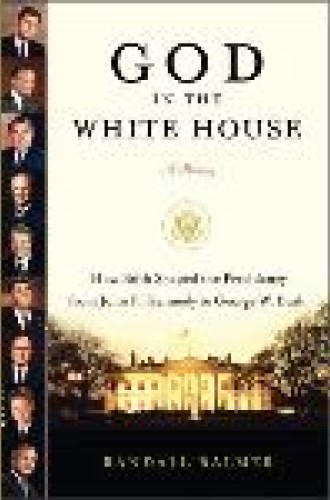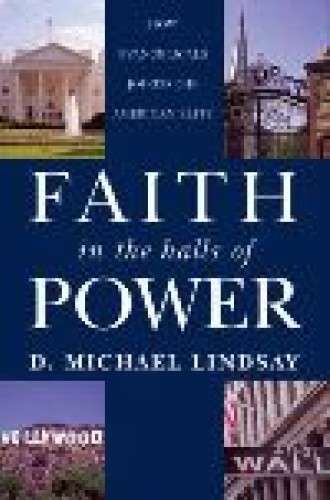Piety and power
Is religion playing a greater role in public life? Rice University sociologist D. Michael Lindsay answers this question with a patiently researched and carefully nuanced yes. From 2003 through 2006, he conducted interviews with 360 evangelicals who work in culturally prominent fields. These informants affirm the unique authority of the Bible, have a “personal relationship with Jesus Christ” and “take a transforming, activist approach to faith.” Slightly more than 200 of them work in secular institutions or fields; nearly 160 of them work in religious organizations. Their ascent to positions of power since 1976, Lindsay writes, “is the result of the efforts of a select group of leaders seeking to implement their vision of moral leadership” by using what he refers to as “convening power” to gather like-minded evangelicals in networks of support and action.
In Faith in the Halls of Power, Lindsay devotes two chapters apiece to describing these networks among evangelicals in four areas: politics, higher education, arts and culture, and the corporate world. He traces the rise of groups that support evangelicals—groups like the Fellowship, which bridges party and policy divides among elite governmental officials in Washington, D.C., by gathering its members regularly, out of the limelight, for prayer.
Lindsay also treats the development of institutional networks focused on the academic study of American evangelicalism. He surveys the tensions between evangelicals who endorse safe commercial pop culture and those who advocate more challenging elite art, and he explores the work of Act One, a nonprofit group based in Hollywood that prepares “young people of faith for careers in mainstream film and television.” Groups such as the First Tuesday Club and the CEO Forum connect evangelical leaders working in corporate culture.
Lindsay’s book will help readers understand an evangelical quintessence: that faith must be lived out in and through the surrounding culture. A brief look at the range of informants listed in the appendix reveals that evangelicals are not separatist world-shunners. They lead companies such as Coca-Cola, the National Human Genome Research Institute, Herman Miller, ConocoPhillips, Helzberg Diamonds and Cisco Systems, and they work on television programs such as Saved by the Bell and Real Time with Bill Maher.
Moreover, Lindsey excels in demonstrating that evangelical is not a synonym for religious conservative, a designation that can do good work but unfortunately can also degenerate into an epithet. Evangelical Christians occupy a range of theological, political and social positions. Lindsay’s work provides texture that can deepen conversations about religion in public life. He shows that evangelicals engaged in the political process do not speak with one voice as they aim to be faithful Christians and that evangelicals working in Hollywood also struggle in various ways to honor both the claims of faith and community and the claims of artistic integrity.
In the fields of higher education and business, at least as Lindsay interprets them, evangelicals have enjoyed a greater measure of success in reconciling faith and work than they have in the fields of politics and the arts. As money from the Lilly Endowment and Pew Trusts has supported first-rate scholarship on evangelicalism, the phenomenon of the evangelical scholar as the epitome of American intellectualism—clear about commitments and careful in judgments—has taken hold.
Likewise, evangelicals who excel in the business world have established a unique beachhead—the corporate parachurch organization, distinguished by its focused efficiency. Why have evangelical academics and businesspeople succeeded in crafting more effective bridges between faith and culture than evangelicals in government and the arts? It may be that evangelicals at the top of corporate and academic hierarchies possess greater autonomy than their coreligionists in government and the arts, beholden as the latter two are to parties, political processes, the market, shifting tastes and impermanent funding.
One shortcoming of Lindsay’s book stems from his presentist sociological perspective. Evangelicals have not just recently “joined the American elite,” as the subtitle proclaims. Contrary to Lindsay’s claim that evangelicals have been “long lodged in their own subculture and shunned by the mainstream” and were “once confined to the lower ranks of society,” they have traditionally constituted the American elite. He does briefly refer to their dominance in the 19th century, but he writes out of a concern for the present situation—probably in response to the alarm that some nonevangelicals feel when they see these openly Christian folks so much in the news.
Lindsay should have contextualized this latest episode in the story of American evangelicalism’s prominence—a story that, even briefly told, could include the popularity of Jonathan Edwards’s new religious vision, the evangelical inspirations of the Revolution and the early years of the virtuous republic, antebellum religious reform, the turn to missionizing the world to expand “Christian civilization,” Social Gospel optimism, postwar anticommunism, and the righteous fire of both the civil rights movement and early second-wave feminism. Lindsay may not have wanted to get bogged down in a “Christian America” narrative, but he should have observed the past seasons of evangelical flowering.
The most important insight arising from Lindsay’s research is that there is no univocal evangelical project, no centralized plan to constitute a new evangelical establishment. The networks that have lately energized evangelicals have been and continue to be negotiated among people who hold a variety of perspectives. True to their roots, evangelicals are thriving by adapting to the wider culture—diffusing American pluralism through the evangelical community.
Randall Balmer, professor of American religious history at Barnard College and currently visiting professor at Yale Divinity School, has written about a much smaller elite cohort. He considers how the faith commitments of recent presidents have guided—or failed to guide—their political actions. He follows the tides of presidential religion from John F. Kennedy to George W. Bush. (An appendix includes speeches illustrating the religious commitments of Kennedy, Johnson, Ford, Carter, Reagan, Clinton and George W. Bush—although not all of these speeches receive adequate attention in Balmer’s analysis.) Balmer begins with the campaign of 1960 and Kennedy’s speech about his Catholicism. He ends by observing that George W. Bush’s identification of Jesus as his favorite philosopher signaled religion’s full-scale return to the presidential résumé.
Unfortunately, Balmer does not completely answer the important question of how faith shaped the presidency. In this campaign season, one might meaningfully explore the American public’s shifting expectations about the religious bona fides of the chief executive, but the stepping-stones of this book’s chapters lead instead to Balmer’s scathing conclusion about how personal faith should positively shape the president’s use of power.
God in the White House catalogues telling moments in each president’s term that reveal his religious commitments. Balmer recounts how candidate Kennedy won last-minute support from black Christians with a reassuring call to Coretta Scott King after her husband was jailed. He explores Lyndon Johnson’s determination to follow “a kind of ‘golden rule’ Christianity” that demands, in Johnson’s words, that “the strong . . . care for the weak.” Balmer surmises that this principle led Johnson not only to promote civil rights legislation but also to deepen American involvement in Vietnam.
Balmer pulls no punches in reviewing the Quaker-born Nixon’s treachery, repeating a couple of times Norman Vincent Peale’s observation that the disgraced president never let his religion “bother him.” He portrays Ford’s pardon of Nixon as a religiously motivated act of mercy and gives ironic credit to Carter, the nation’s first born-again president, for the development of the religious right: evangelicals initially supported Carter but transferred their allegiance to Reagan when segregated religious schools came under IRS scrutiny. (Balmer repeats this argument—and it does bear repeating—from his previous book, Thy Kingdom Come: How the Religious Right Distorts Faith and Threatens America.)
Balmer forgoes the opportunity to reflect on George H. W. Bush’s compartmentalization of reputedly broad religious views for the sake of winning conservative political allies. He cites Clinton to illustrate one of his larger points: that no correlation necessarily obtains between a president’s religious avowals and personal conduct. In tones revealing the book’s purpose as more jeremiad than history, Balmer saves his bitterest bile for our current president. He decries the discrepancy between Bush’s religious confessions and his much-discussed failures of integrity.
The tone of God in the White House is more polemical than that of other books on the subject—studies such as Kenneth Wald’s Religion and Politics in the United States (now in its fifth edition, with new coauthor Allison Calhoun-Brown) and Clyde Wilcox and Carin Larson’s Onward Christian Soldiers? The Religious Right in American Politics (now in its third edition). Balmer’s review of presidential piety builds to his final chapter, “Cheap Grace,” in which he exhorts readers to hold presidents accountable for their religious talk—to press presidents on their claims about justice, love and mercy. Voters’ unwillingness to hold “candidates and presidents accountable for their professions of piety,” he writes, “renders the rhetoric of religion on the campaign trail meaningless.” By letting politicians “hypnotize us with lullabies about faith and morality,” we betray our own lack of sincerity on matters of faith.
But by asking readers to pay closer attention to presidents’ religious integrity, Balmer may move us farther from the “Kennedy paradigm of indifference” and closer to a domestic atmosphere that mirrors President Bush’s November 2001 warning to the world: “You are either with us or against us.” Balmer hopes that the electorate’s healthy suspicion of candidates’ professions of faith will “reinvest both religion and the political process with a profundity befitting the importance of both.” Yet his recommendation may instead invite a heightened polarization marked by the “vacuous” spirit that he bemoans.
Many voters already stand guard along the boundary between religion and politics, gauging candidates’ sincerity. Is Balmer angry not because voters are indifferent to presidential religion but because he feels that the wrong folks are concerned about it? Profundity is in the eye of the beholder, after all. Lindsay’s book reminds us that people who share a religious tradition do not always agree. Perhaps Balmer should not dismiss the portion of the electorate that wants to invest the president with the powers of a high priest. His labeling of such investments as foolish and naive ignores the tremendous burden of meaning that many Americans, in good faith, place on their elected national leaders. To tell voters, in essence, to grow up and get wise to political reality ignores the needs that already compel citizens, for good or ill, to choose leaders who, in the best of times, embody the nation’s deepest stories about itself.







